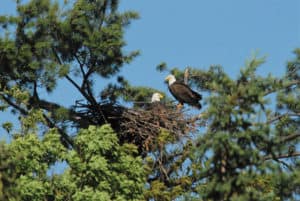Seven species and three critical habitats received updated conservation designations on Vermont’s endangered and threatened species list, including the highly anticipated de-listing of the bald eagle after over a decade of restoration efforts.
“The bald eagle’s de-listing is a milestone for Vermont,” said Wildlife Division Director Mark Scott. “This reflects more than a decade of dedicated work by Vermont Fish & Wildlife and partners. It shows that Vermonters have the capacity to restore and protect the species and habitats that we cherish.”

A pair of bald eagles sit on a nest high up in the tree canopy in the town of Barnet.
That conservation capacity will be essential moving forward.
Along with de-listings for the bald eagle and short-styled snakeroot, a flowering plant of dry woodland habitats, the update to the state endangered and threatened species list included a range of new listings.
Two invertebrate species, the American bumblebee and a species of freshwater mussel known as the brook floater, and two plant species, Houghton’s sedge and rue anemone, have been listed as endangered. State endangered species are considered at immediate risk of becoming locally extinct in Vermont.
One bird species, the Eastern meadowlark, received a new designation as threatened. State threatened species are considered at risk of becoming endangered without timely conservation action.
Three important landscapes also received new designations as critical habitats that are essential for the survival of threatened or endangered species in Vermont. The newly listed sites support species including the common tern and Eastern spiny softshell turtle, as well as little brown, Northern long-eared, and tricolored bats.
“These new listings reflect the stressors affecting Vermont’s plant, fish, and wildlife species,” said Wildlife Diversity Program Manager Dr. Rosalind Renfrew. “In the face of climate change and habitat loss, our mission is to conserve these species and others to the very best of our ability on behalf of all Vermonters, who demonstrate time and again that they care about the survival of wildlife populations.”
The new listings are a vital step towards enabling the department to carry out that mission. They trigger additions to existing species and habitat management plans, development of recovery metrics, initiation of population monitoring, and strengthening or establishing critical partnerships.
“We dedicate incredible resources through population monitoring, habitat conservation and improvement, and education and outreach to preventing species from reaching these thresholds in the first place,” said Scott. “But, when necessary, we also draw on our successful track record leading endangered species recovery efforts including restoring Vermont’s populations of common loon, osprey, peregrine falcon, and now the bald eagle. We will bring that same dedication to each of these new listings.”




